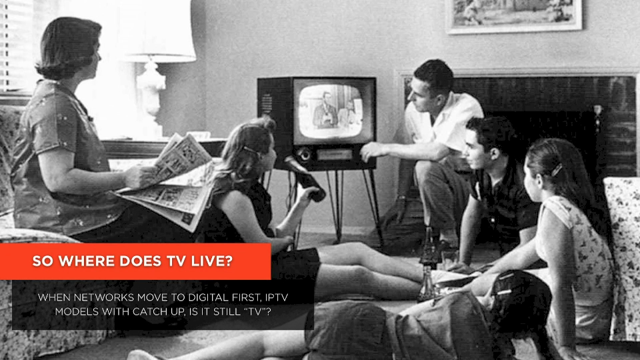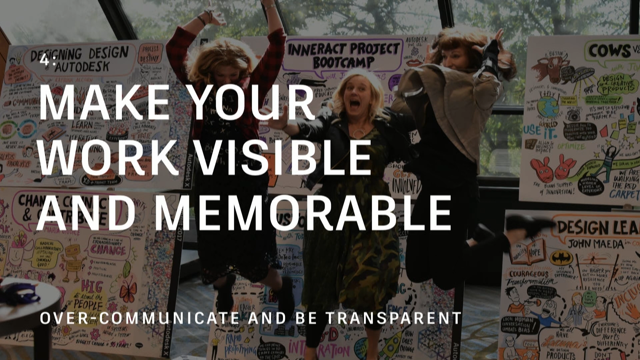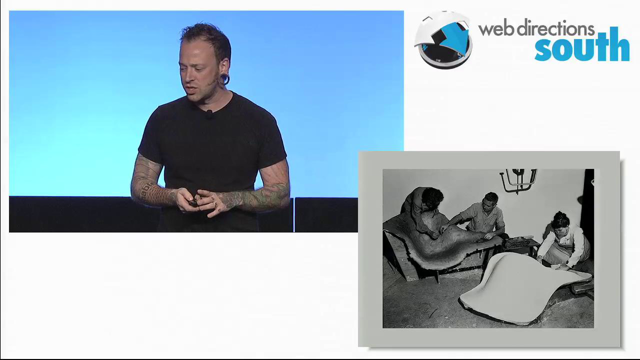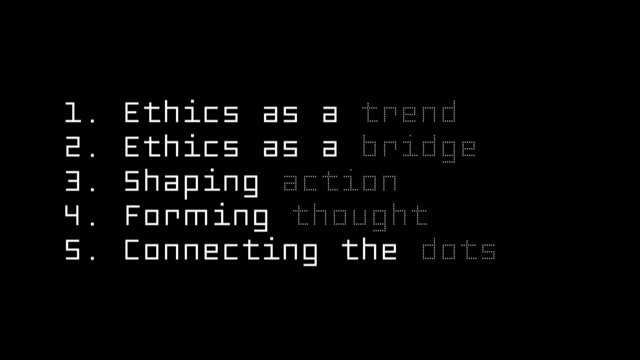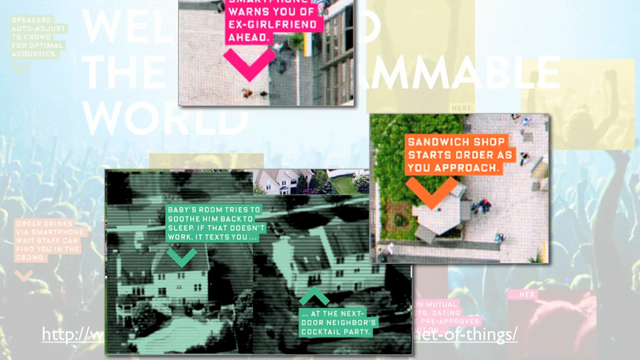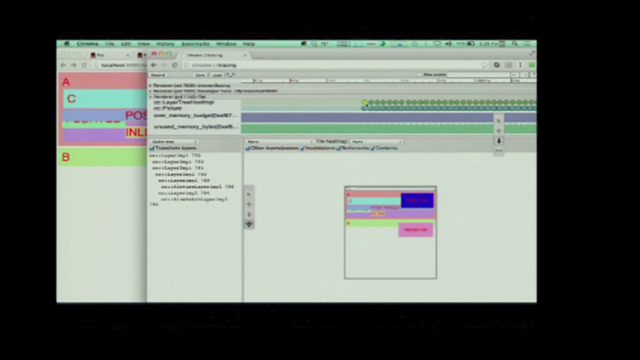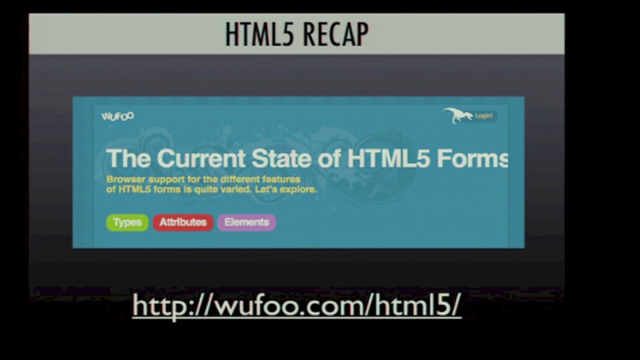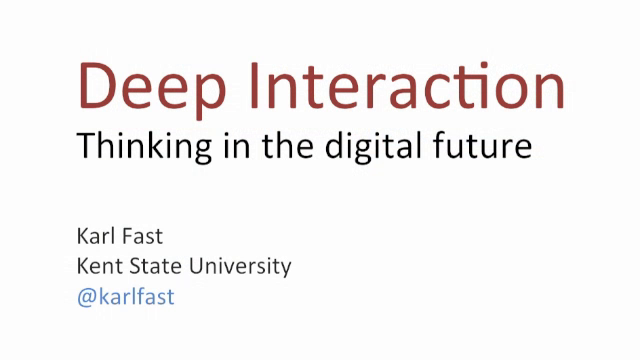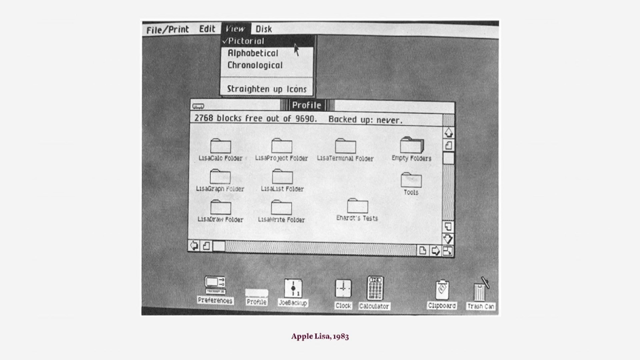
thanks for having me this is my first time in australia my first time in web direction so it's really exciting to be here i think we've heard about a lot of really exciting technology here in the last few days and you know you look around in our own lifetime and you look at something like the television set and it wasn't that long ago that they weighed 100 pounds and they were heavy to put on a table surface but now displays are lightweight paper thin high resolution you look at our computer processors and they can calculate things tens of thousands of times faster i mean in the last two decades we've built an incredibly useful internet and we've been able to access it in the palm of our hands but there's a terrible trend emerging in technology today and i think it's taking us away from what really matters now i i work in tech so i'm partially blamed for this awful trend and a lot of you do too so you might be to blame as well but i think if you listen closely today you can hear how we can move past this awful trend and build a better tomorrow now i'm a ux designer that to me that means i solve people's problems and right now i do that at samsung design america where we create new technology to solve people's problems and before i do that at cooper which is a design consultancy in san francisco where we solve problems for customers of startups to fortune 50.
now it's my personal goal to solve problems but i think as an industry we're writing a way that's taking us away from solving people's problems and what's so crazy about this awful trend is that it came from something so good about 40 years ago we were able to build smaller computer components that meant we could build smaller computers desktop computers we brought them into the workplace but we forced people into this awful user experience we forced the everyday person to use the command line user interface to speak in a language written by programmers for programmers for computers but then we got this xerox labs ideas of a window an icon a menu and a pointer and wimp converted to our first mainstream graphical user interface and it was so good we could point and click we could drag and drop what we saw is what we got and about 10 years later when we could start touching those interfaces it was even better but today our love for the digital interface has gotten completely out of control it's become our answer to everything how do you design a better car slap an interface on it a screen in the middle of your speedometer so instead of checking how fast you're driving you can check your facebook and your twitter how do you how do you design a better vending machine slap an interface on it so instead of pressing a couple buttons you can swipe and tap through buttons that kind of look like buttons how do you design a better trash can you slap an interface on it a screen that shows you that it's raining outside while you're standing in the rain outside how do you design a better toilet this is the ipod which was debuted at ces last year it's a children's toilet with a screen on it you know somewhere along the way we got confused we started thinking user experience is the same thing as user interface and you see this on job postings everywhere looking for ux comma ui designers and it's led us to become surrounded by screens you know your workplace isn't decent if you don't have at least two monitors your smartphone isn't good if it's not at least five inches you know we have over 1.2 million mobile apps it's come to the point where our greatest minds aren't advancing science or taking us into space but they're working at facebook on ads for all of these screens you know it wasn't that long ago that our lives were surrounded by paper and we dreamed of a paperless world now instead our lives are surrounded by screens and i think we should dream of a screenless world i actually think that the best interface is no interface and i'd like to show you how we can get there i've created three principles they're not about things but they're about us because it's us that we should be designing for the first principle is to embrace typical processes instead of scripts recently a couple of major car companies have released apps for smartphones that are supposed to be an improvement on the car key they let you do things like unlock your car doors from your smartphone it sounds great in tech vlogs but let's sort of figure out how that really works i walk up to my car and i want to unlock my car doors so i pull out my smartphone i want to unlock my car doors and i wake up my phone i want to unlock my car doors and i slide to unlock i want to unlock my car doors and i enter my passcode i'm looking to unlock my car doors and i hit the home button to exit my last opened app i'm looking to unlock my car doors and i hit my home button to exit my last open group i'm still looking to unlock my car doors and now i swipe through a sea of icons looking for that app to unlock my car doors there it is this is a corner it's kind of hard to find and i want to unlock my car doors and i tap to launch the icon launch the app the app loads and i end up with this incredible map of north america i'm looking to unlock my car doors and it's really hard to figure out but there's a center option there that says control so i'm just going to go ahead and guess that maybe that might be the way to unlock my car doors go ahead and tap control now we have this list option where there's incredible features here like a google search which is exactly why you'd launch a bmw app um but one of the options there says locking slash unlocking so i'm here to unlock my car doors and i go ahead and tap on that button fortunately i end up with a slider one way is locked the other way is the unlock so i slide to the right to unlock it says data transfer successful i think that means my car doors are unlocked now um and yeah i can finally physically open my car door is this an improvement on the car key i don't think so right i mean if you kind of break down what happened there there was me right and walking through my car there was all the steps i had to do with the digital interface and then there was really my goal which is to open the car door but let's say we embrace this first principle let's say we embrace typical processes instead of interfaces well we'd end up with something like this two steps seems kind of crazy seems kind of out there but in the late 90s before we got caught up with apps and screens mercedes-benz created this technology called keyless go you pull the door handle and sends out a low frequency radio signal if your keys are in your pocket or in your purse the car door is unlocked and you can open your car door so it embraces a typical process all you do is pull open the car door handle now some people say well you know okay this is really nice but the app is really useful when you forget your keys when you lock your keys in the car but the beautiful thing about mercedes keyless go is it always knows where the keys are so you can't actually lock your keys in the car you know the entire automotive industry is filled with screen based thinking this is something called viper smart start it's an app that's been featured in aol auto blog and end gadget and it actually looks kind of better than the one we were just looking at you know it's got four or five common actions and big icons but we think this is good because we're used to looking at screens we think this is decent because we analyze wireframes but let's look at one of these actions opening your trunk and instead of screens let's start with insights this is what someone looks like when they're carrying something to the trunk of their car this person happens to be mitt romney who ran for president united states and wanted to be the everyday man so let's say here he represents the thing he always wanted to be he's carrying something in the trunk of his car he's got his hands full he probably doesn't want to put this heavy thing down pull out a smartphone and go through all those crazy steps and the design team at ford realized this they realized that even though his hands are full his feet are free so they put a sensor underneath the bumper of the car it looks for a shin and then a foot kick and the trunk opens you know good experience design isn't good screens it's good experiences when i got off my flight here in the sydney airport i saw this ad it says what if your phone could make your car cooler and in the corner it says innovation that excites and this is an app from nissan and you'd go through all the steps and eventually figure out a way to cool off your car now you know on a hot day this is actually kind of useful right you mean utility wise you can cool off your car but it embraces screens right not typical processes on a hot day when we go somewhere like a shopping mall we park our car and we go inside we do the thing we really want to be doing at the mall right which is shopping watching a movie you don't pull out your phone in the middle of a movie to cool off your car it's kind of silly design team at toyota thought about this and they put this really simple sensor a thermometer sensor inside the car when it gets really hot the sunroof opens and a small fan blows out the hot air out of the car and the beautiful thing about the whole about the whole system is that it's solar powered because on a hot day you can assume it's bright outside so it doesn't drain any energy from the car it doesn't use any gas to work the second principle is to leverage computers instead of catering to them computers are incredibly smart things they can calculate incredibly complex stuff but we treat them like they're three-year-olds we make them that way and so they say bizarre things back to us like this this is a real error message from microsoft and it happened because of this bizarre relationship that we have with computers see we serve computers we have to memorize countless passwords with an uppercase letter a number punctuation mark we have to remember our best friends childhood dog we have to search complex databases for simple information i say let's reverse this relationship let's have computers serve us a few months ago an emergency room physician contacted me about a headlamp that does just this see this emergency room physician does cave search and rescue which is by no means an easy task it requires crawling the small crevices searching for panicked survivors and he emailed me about this headlamp it's made by petzl after 40 years of making headlamps petzl didn't slap an interface on it they tried to solve a problem see when you're doing search and rescue bright high beams necessary to look into a deep dark cave but that same bright beam whitewashes a map you're holding a map that will lead you to the survivors so pets will put a microchip and a light sensor in the headlamp and when you look at your map the light dims and when you look further away the light brightens it does more than take away an inconvenience it actually makes the physician better at his job when we serve computers we fill up databases but when computers serve us they can help us do great things like save lives you know computers should do things that we don't want to do or things that we don't even know we should do when barack obama ran for president 2008 he gave a speech that said that america could reduce its dependency on foreign oil if its citizens properly inflated its car tires the idea was mocked by the opposing party who sent out these tire pressure gauges with obama's energy plan printed on them but on this particular issue it turned out he was right if you properly inflate your car tires you can actually save gas reducing foreign dependency on oil in fact if you properly inflate your car tire it's actually safer but this isn't a really commonly known thing and actually everybody here and now knows about it since i've shared it with you guys but it isn't a very fun experience even though you all know about it you probably won't do it i mean you go to the gas station you have to pump quarters in this machine to buy air which feels like a weird thing to do and then you lean over and you kind of show the world something you don't really want to be showing them so what does a major tire manufacturing company do about this well goodyear has an app and it lets you do incredible things like print and email brochures but fortunately goodyear i started i think beyond scripts and in their innovation lab in ohio they've made this this is a self-inflating tire there's a little mechanism inside the tire and while you're driving it checks to see if the tire pressure is right and if it isn't a valve opens and fills with air always giving you the right amount of air pressure the third principle is to create a system that adapts for individuals everyone here is unique you're all sitting in your chairs in a unique way you're all wearing different outfits you all have your own favorite way of doing getting something done but that's not how we build software we build software based on commonality we it takes a really smart team to solve some problems for some people but there's a different form of thinking and that's data science that looks more individuals and it's given us some things and interfaces like linkedin recommendations about people you know or jobs you might be interested but there's so much more that data science can do when we leave interfaces behind data science can really start to thrive a very simple example is nest right it looks like on the outset a thermometer with a screen slapped on it but when it gets interesting is when it learns about you when it learns what kinds of temperatures you like over the course of a day a month a year and uses its sensors to know if you're home or away and eventually you don't have to interact with it at all it becomes a no ui experience but interfaces in general forces to be reactive and no ui could allow us to be proactive this is early sense it's a sensor built for hospitals that slides under a hospital bed and what it does is it reads your vitals instead of all these machines that kind of wires and stuff that you hook up to early sense sits underneath the mattress and it reads your heart rate and your pulse and it lets you allow lets you rest in the bed as you normally would see a typical hospital machine is reactive it reports things after they happen and it is based on sort of generic data right these are this generic limitation here and then a generic alarm just kind of blasts into the hospital in fact these generic alarms that just kind of go off when a patient is in trouble is actually a problem the boston globe found that from january 2005 to june 2010 over 200 people died in the united states because an alarm went off generically in a hospital and a healthcare worker didn't realize so over 200 people died because of a generic alarm that wasn't noticed but early sense is different it gets to know you it understands your patterns it understands you as an individual level and when something is wrong about your patterns it alerts your healthcare provider that something may be wrong and it can actually help identify things hours ahead of time we are all different and a world of no ui can embrace that reality so i first published the best interfaces no interface in august 2012 on the cooper journal and it kind of took off and a lot of people started tweeting about it he got some press in the verge and on bbc google has recently started to use some of the phrases like no interface or screenless computing other people have written written negative pieces like no to nuance no to no ui scott birkin said who cares about any of this but along the way there's been a lot of interesting discourse one of the things people have brought up is automatic solutions a lot of people are afraid of automatic solutions and they should be they're really hard to get right but when you get them right they become an embedded part of our lives automatically deploying airbags for example save our lives in car accidents we don't even think twice about automatically sliding doors which are in hospitals and markets but i think the most interesting automatic solution is automatic transmission right i mean can you can you imagine walking through an executive boardroom and proposing an automatic solution for one of the most dangerous places you can be driving down a freeway having a machine automatically shift gears i mean this is pretty nuts and you do a little bit of market research and you realize that people who really love driving hate automatic transmission but the common everyday person loves automatic stuff when it works right in the united states by 2009 91 of all cars sold had automatic transmission what about failure right i think any great system considers failure as a possibility i mean even an automatic sliding door which is not life on the life or death matter has often a failure mechanism if the power goes out you can push to open the doors but what some people have started to do in these more complex systems is they've shifted the ui from being the primary to being the secondary interaction i think this is a really nice shift actually the headlamp that i showed earlier petzl headlamp has a piece of software that comes with it that not a lot of people probably use but allows you to adjust what those beams exactly will be nest of course as i showed always has an interface available to you and early sense being in a medical environment really needs to be transparent about what's going on and so there's a complex ui that goes along with it what about the web i mean this is a web conference i've been talking a lot about products or apps what about things that live online well is no ui possible absolutely i mean this is tripit right it's a web service but it has the capability to scan your gmail and self-populate your calendar with your flight information with your itinerary information with no interaction needed no ui needed from the user's perspective pandora's goal is to eventually get to know you well enough so you just put on your headphones and press play and there really isn't any interaction beyond that even mint has some of these no ui features where it's always working for you in the background and if something happens like a foreign transaction fee it'll let you know about an even suggested credit card where that's not the case so this is kind of a fun topic to talk about and it's funny and it's great but how do you really do this right i mean this is really complicated and not easy to create these no ui systems when i first published the piece i quoted something that donald norman who's an author and northwestern professor said about interfaces and after it got popular we exchanged some emails and we did a little bit debate a little bit of a debate he took the anti-position i took the pro position and we kind of engaged in an audience and and talked through no ui and at the end i handed out this worksheet and this worksheet was focused on how and it was based around the three principles first principle is embrace typical processes instead of screens and so i put some of these observations on on the sheet of paper the second principle is leverage computers instead of catering to them and one way to do that is to take advantage of the growing list of sensors that are out there and even the devices out there that have pretty simple sensors in them this is twine that has a couple built-in motion which has some really nice gestural sensor and it's shown here with a ui but it could be used for all sorts of things and so i list put a list of sensors on that same worksheet the third principle is adapt to individuals and there's a huge growing set of different platforms that can allow for great data science and a never-ending list of apis and public data sets that you can pull from and i put on there a little bit of the data science we gave everybody 10 minutes just 10 minutes a room of people who had never met each other before 10 minutes to come up with a solution to one of these observations and some of the ideas were kind of silly i mean one of the things i put on there was about senior citizens forgetting to take their medication and there's been some progress in coming more clear about prescription medication and target has worked with a woman endeavor alder to create these more easy to read prescription bottles but a lot of people still forget to take their medication and so this group came up with the idea of using your nose as a notification system so that when your last pill runs out it smells like pine in the room and that reminds you to take another pill kind of silly kind of out there but a lot more interesting than your typical notification system that's screen based another problem i put on there was around running shoes now i'm a runner and the only piece of equipment you have when you run is your shoes and unlike your leisure shoes uh your running shoes wear out when the soul compresses so as the more and more you run the more your soul compresses and it becomes unsupported to your knees and your ankles and there's all sorts of shoe trackers out there all sorts of apps and websites where after you go running you come back home and you enter how many miles you ran and then it kind of guesses if your shoes are dead or not but what one of the groups thought is you could put a little piece of dye inside the sole and when the sole compresses enough the dye explodes and it turns red it's a no ui solution that lets you know what's going on they even thought you could put a small radio and white and battery in there so that when your shoes compress it orders you a new pair of shoes off zappos pretty awesome actually i shared this idea at south by southwest and a guy from zappos came up to me afterwards to ask who those people were and if he could hire them anyway so this was one of the ideas that came out of the workshop and some people criticized it you know they said this is running shoes what does this have to do with technology a few months later i started to get a bunch of emails in my inbox because a patent surfaced from apple they put a sensor in the heel of running shoes and if something went wrong led lights would light up i mean there was a room full of people who had never met each other before and in 10 minutes came up with nearly an identical idea that a room full of apple designers came up with and decided to spend legal fees to patent there's a lot to talk about with no ui there's a lot of places we can go with it you'd always feel free to tweet to me or send me an email some of the more interesting things that are going on is that people using this no ui hashtag and starting to have conversations around where this idea could go i've started to build a website called no interface.com and right now it's really not a whole lot on it there's videos of me which is kind of a meta moment and you can also download a pdf packet which has the worksheet that i shared at the workshop the original essay and some slides from this presentation there's a so much to celebrate in technology today but there's an awful trend dominating a lot of our thinking and i hope you've heard some ideas about how we can get away from it thanks thanks very much golden uh any questions or comments for gold please raise your hand if there is yep one over there hello hi er the way i see it basically in a sense what you're talking about is automation and maybe i should start from the end saying i don't want it to be portrayed like i disagree with you because i think to a large extent we can definitely find great ways to make users life easier exactly like your show however once you open that topic for discussion i think you should also regard and i would be happy if you will regard now issues of a responsibility moral and ethics and by that i mean for example if you have a adaptive course controls that take away the interface and basically let the car decide when to accelerate and decelerate a few years ago in united states toyota carl decided to accelerate by themselves a person in a situation like that crashes who is accountable united states army today and other armies around the world develops a mechanism that can basically patrol the borders identify movement and take down the target automatically no interface at all however the decision at the moment is not to implement so i think issues like that should be regarded yeah absolutely i mean you have to be transparent and responsible with anything that you create in technology whether it has to do with these ideas of no interface or something else right we have so much power and such great ability to do so many things i think a lot of this relies on data tracking and understanding the people that your users and i think you have to be transparent about what you're tracking how you're tracking it and you have to always provide for people a way to shut that off i mean i think it's easy to get irresponsible i mean we see this in privacy ways with websites like facebook or google all the time and i think that having that transparency and having that responsibility is absolutely important it's hard to police it for sure um there is no universal body right now that that does that kind of thing but you're right this this and any other sort of technology that's emerging can always be scary if it's in the wrong hands and used in the wrong way golden you work at samsung but you didn't actually mention any of the work you're doing there are you able to talk about anything unfortunately i'm not is okay something from apples here well as uh before we've got a bit of time to kill so what about the coffee is not gonna be ready yet for another half hour or so why don't we do one of the challenges that you set for your your people in the works oh wow is that possible today could you maybe put up an example of a scenario that we need to work on maybe we could all people could talk amongst themselves yeah one of the scenarios um well let's let's pull that out not ready for this but i can get ready okay i should have this hidden somewhere oh no one can see it perfect did we put you in the spot no it's fine okay how should i do this okay great thank you can you see that okay great okay so this is the no ui worksheet that you can actually download online and to the right there these are the the example problems um so the first one says mike can't function without good sleep but he's a new parent with a baby that needs attention throughout the night he wishes he had a better way to get rest so what we did in the workshop is we give people one of these problems right hopefully you can read them but it goes a through f there and then you can choose so you choose sort of this is a sample potential toolkit this is not necessarily everything that's in your toolkit but these are some things you can consider while you try to create a no ui way to solve these problems and at the top are the no ui principles right trying to embrace typical processes leveraging computers but it's really the thing on the right choosing one of those problems to solve and then using some of the tools on the left that's how the worksheet works um i can here you know what i'll show you an example of how a team solved it so i gave these these second uh sheets here on the right which is just kind of like a cartoon script right and you kind of draw out the problem and so this is the example that i talked about earlier using they chose to use an internet connection and to use a dot colored dye and then they applied it to craig's problem of of his running shoes and they'd made this drawing that i edited later this is craig he needs to get shoes every 300 miles when his shoes need to get replaced his midsoles turned to the color red so it doesn't even take a whole lot of steps to explain the idea i mean this happened in three panels here but yeah feel free to take a shot at talking to your neighbor about some of these potential no ui no ui solutions to some of these problems how does the um transport safety authority feel about the little wi-fi radio in their shoes it's a it's a good question i don't know okay well feel free to talk amongst yourselves about that but otherwise um please thank german thanking golden christian as well thanks

